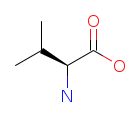Valine
Emil Fischer has isolated Valine from casein back in 1901, which was achieved by hydrolyzing proteins. Today Valine is recognized as the branched-chain essential amino acid providing a stimulant activity. Actually, three branched-chain amino acids constitute over 2/3 of the amino acids in the body proteins, pointing out that its role for humans is invaluable.
Chemical structure of L-Valine

Identifiers and properties of Valine
IUPAC Name: (2S)-2-Amino-3-methylbutanoic acid
Symbol: Three-letter code - Val. One-letter code - V
Molecular Weight (Molar Mass): 117.14634 g/mol
Molecular Formula (Structural Formula): C5H11NO2
Canonical SMILES: CC(C)C(C(=O)O)N
Isomeric SMILES: CC(C)[C@@H](C(=O)O)N
InChIKey Identifier: RVEPXRXYSLTFTD-UHFFFAOYAI
CAS Number: 72-18-4
MDL Number: MFCD00064220
Melting point: 315 °C
RNA codons: GTA, GTC, GTG, GTT
Solubility in water: 85 g/1 L (20 °C); pKa - 2,32; pKb - 9,62
Rf value in n-butanol/acetic acid/water = 12:3:5 - 0.61
Side Chain polarity: Nonpolar
2D Molfile: Get the molfile
3D PDB file: Get the PDB file
Other names: L-2-Amino-3-methylbutyric acid; (S)-α-Aminoisovaleric acid; L-alpha-Aminoisovaleric acid
What are the functions of the Valine?
This amino acid aids preventing the breakdown of muscle, because it supplies the muscles with an extra glucose responsible for the energy production during physical activity. Valine is also a precursor in the penicillin biosynthetic pathway and is known for inhibiting the transport of Tryptophan across the blood-brain barrier.
In other words, Valine is an essential amino acid important for smooth nervous system and cognitive functioning. Valine is one of the three branched-chain amino acids, along with Leucine and Isoleucine. This amino acid cannot be produced by your body and must be obtained through food or through supplements. Valine is important for everyday body functions and for maintaining muscles, as well as for the regulation of the immune system. This particular amino acid is not processed by the liver, but is taken up by muscles. You can obtain it through kidney beans, leafy vegetables, poultry and milk.
Benefits of Valine
Valine provides numerous benefits like improvement in insomnia and nervousness. Besides, it is also proved to help alleviate disorders of the muscles, and to be an effective appetite suppressant. This amino acid also greatly improves the regulation of the immune system, but probably the greatest benefits of Valine are experienced by athletes performing long-distance sports and bodybuilding, because this amino acid is important for the muscle tissue recovery and for the muscle metabolism, while increasing exercise endurance.
Bodybuilders usually use Valine together with Isoleucine and Leucine to promote muscle growth and to supply them with an energy. Besides, this amino acid helps them recover tissues damaged during physical activity. Athletes commonly know that Valine is vital for the muscle metabolism and the growth of muscle tissue as it assists in maintaining the proper amount of nitrogen in the body.
Dietary Sources
Here are some food sources that contain L-Valine along with approximate amounts per serving.
Meat and Poultry. Chicken Breast: A 3-ounce (85-gram) serving of roasted chicken breast provides approximately 1.4 grams of valine. Beef: A 3-ounce (85-gram) serving of cooked beef contains around 1.3 grams of valine.
Fish. Tuna: A 3-ounce (85-gram) serving of cooked tuna provides about 1.4 grams of valine. Salmon: Similar to tuna, salmon contains around 1.4 grams of valine per 3-ounce (85-gram) serving.
Dairy Products. Milk: One cup of milk contains about 0.8 grams of valine. Cheese: Different types of cheese provide varying amounts of valine, typically ranging from 0.5 to 1.5 grams per ounce.
Eggs: One large egg provides approximately 0.6 grams of valine.
Legumes. Soybeans: A 1-cup serving of cooked soybeans contains around 1.9 grams of valine. Lentils: A 1-cup serving of cooked lentils provides about 0.7 grams of valine.
Nuts and Seeds. Almonds: A 1-ounce (28-gram) serving of almonds contains approximately 0.7 grams of valine. Sunflower Seeds: Sunflower seeds provide around 1.3 grams of valine per 1-ounce (28-gram) serving.
Whole Grains. Quinoa: A 1-cup serving of cooked quinoa provides about 1.1 grams of valine. Brown Rice: A 1-cup serving of cooked brown rice contains approximately 0.8 grams of valine.
Dense Protein Sources. Whey Protein: One scoop (around 30 grams) of whey protein powder can provide 1.5-2 grams of valine.
Seafood. Shrimp: A 3-ounce (85-gram) serving of cooked shrimp provides around 1.5 grams of valine. Crab: Crab is another seafood source with approximately 1.5 grams of valine per 3-ounce (85-gram) serving
These values are approximate and can vary based on factors such as cooking methods, specific varieties of food, and preparation techniques. If you have specific health concerns or conditions that may require additional valine, it's advisable to consult with a healthcare professional or a registered dietitian for personalized advice.